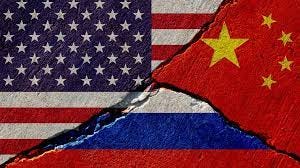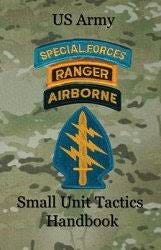DoD must modernize their approach to conflict... and Great Power Competition
Before it's too late
Today’s post can often seem daunting to unravel, for those not immersed in the US national security world, especially regarding how the Pentagon goes about addressing influence. Yesterday’s piece in The Hill by national security expert and bestselling author, Dr. Sean McFate is, 1) a must read because it is Sean’s norm; excellent, open-minded analysis based on evidence and 2) because it reflects the near impossible challenge of rewiring, DoD/ national security community doctrine and thinking.
Full disclosure: Sean’s wife, Dr. Montgomery McFate is one of the prestigious Board Members at our think/ do tank, Narrative Strategies and a renowned expert on understanding the human terrain or more simply, the people and environment where the US national security focuses their attention. When it comes to being a “power-couple” regarding a far better approach to US engagement for national security purposes globally, they are at or near the very top. When either talk, it pays to listen.
Today, I’ll talk about Sean’s excellent article and expand a bit, integrating my own expertise into the equation.
Sean’s article argues a few primary points, but I will stick to a couple that I feel are critical to effectively addressing the needs of our NSS, National Security Strategy
1. “Today’s defense community has forgotten that strategic competition is won through irregular warfare — a dangerous mistake.”
2. “The Defense Department is preparing for a war with China that looks like World War II with better technology, an improbable scenario.”
3. The third point that Sean is spot on about and that I cannot expound on further, due to him being the DeFacto expert, is where and how to house a study group that can expertly facilitate new thinking. Currently we are in desperate need to introduce real analysis, into a stale and decades long failure to understand that modern conflict and great power competition, doesn’t conform to antiquated paradigms.
1.
“Today’s defense community has forgotten that strategic competition is won through irregular warfare — a dangerous mistake.”
Sean’s quote could hardly be more spot on and here’s why; The US and our allies haven’t lost a shooting war since WWII. Every other conflict though has seemed a loss for the simple reason, after the shooting stops, we repeatedly failed to successfully manage the peace. This is made more painful because that we did quite well post WWII in Germany and Japan. Then again, at that time we were not at the mercy of the big defense contractors who are so influential in how DoD and Congress spend money.
Big ticket items like tanks, ships, planes and missiles are but a few examples of how we have overinvested and become disastrously addicted to intimidation and deterrence as the only regularly employed influence tactics. Every single aspect of warfare or GPC, Great Power Competition revolves around influence, negative, positive and sustaining. We must simultaneously employ ethical influence to maintain close alliances via building trust, sharing information and tactics and sustaining a posture that supports deterrence. On the other hand, we must persuade adversaries or unethical competitors like Russia, China etc. that aggression and violating the laws, policies and standards of the RBIO/ rules-based, international order will induce consequences.
These roles don’t exclusively pertain to the national security community. Influence, especially on a strategic level requires the agile, hands-on, well strategized participation of all US and allied agencies. By example, while I was operating in Afghanistan, one of my most valuable resources was support from the Department of Agriculture. Providing them access to local villages and provincial leadership not only paid dividends for local people but also were key in keeping the Taliban less influential in those provinces and districts.
As Sean notes, IW or Irregular Warfare is a key component of what US Special Operations can provide to the influence equation. Long before the CT, counterterrorism mission, popularized by Hollywood as door-kicking and hair-raising missions, SOF executed the IW mission with excellence. There are those hair-raising mission too but, that is not the primary SOF function. USSOCOM was and still is the tip of the spear in influencing via well-established and well executed missions to support local populations with security needs and more. The problem is that national security strategists, fail to produce a strategy that employs these experts in support of influence. This is because they don’t understand that their mission is to influence, not fight the pitched battles of WWII. Not only was this their original mission but they excel at it. SOF (Special Operations Forces) also excels at countless other mission skills that contribute to US national security in IW. These won’t be discussed.
The only good thing about Putin’s brutal war on a sovereign neighbor, Ukraine is that it is forcing the US community to rethink its tired old addiction to antiquated thinking and doctrine. This will not help so long as this is an exercise of thinking only. We will continue to fail until we begin significantly changing our way of doing business. Anecdotally, I, not long ago attended a large-scale military exercise with Japan, to plot out how to address China. I ran headlong into a buzzsaw for suggesting that we rewrite the exercise scenario to something that China will very likely do, rather other than using the barely modified script used for a couple of decades. It ended poorly for me and yet, here we are a couple of years later and Sean has keenly noted the exact same thing. He is again, spot on.
In summary to this first point, here’s how it goes:
a. From a military perspective, those specialized in IW must be integrated into a real strategy for GPC, not the extinct scenarios being employed by DoD and resources by big defense contractors making billions from staying the course of failure. Don’t get me wrong though, there is a critical role for big-ticket hardware too, but not to the exclusion of implementing and improving our capabilities regarding IW.
c. I will also add to this, the original note I made about Sean’s discussion regarding where to house the entity that will rethink this issue and bring DoD into the 21st century. Follow his advice.
2.
“The Defense Department is preparing for a war with China that looks like World War II with better technology, an improbable scenario.”
Sean’s assessment of a nascent shooting war with China is again, beyond insightful.
“But here’s the problem: It will not happen, at least not like this, and we may be learning the wrong lessons. As the Cold War teaches, competition between nuclear great powers risks World War III Armageddon, and why the USA and USSR avoided putting their troops into direct conflict. The nature of war is escalation, and no one wanted another 1914 Sarajevo moment with nukes.”
Let’s take a slightly deeper look at why his assessment is accurate.
First and foremost, China has no idea how their military will perform. Our intelligence community doesn’t have a full grasp of this either. Case in point, they gave Putin’s military credit for being capable when there wasn’t a single reason that supported this assessment. Counting ships, tanks, planes and radars etc. are no measure of a military’s competence. Not only did their equipment fail but even more importantly, their troops failed and still do… miserably.
China’s military has had zero combat experience outside of China since 1979, when Vietnam handed China a serious defeat. They are still humiliated. Sixty to seventy percent of China’s weapons systems are either Russian, patterned on Russian hardware or Chinese manufactured weapons systems based on Russia’s. For the record, this is a problem for India as well, who still enables Putin’s brutal assault on innocent Ukrainian victims, via their purchases of Putin’s fossil fuels and their willingness to increase trade to provide Russia with materials they lost due to sanctions. China does precisely the same.
It's beyond prudence, that Xi would toss his military into a full-scale conflict to reacquire Taiwan without being able to depend on Russia and with a military grossly untested and based largely on Russian systems. Considering that Xi has made so-many critically poor strategic decisions these past 6 or 7 years, a military humiliation by US and allied militaries, all combat tested for two decades is most unlikely.
Summary:
The US national security community has more tools, resources and experience than any other top tier nation on the planet. Yet, we still fail to understand and strategize on the core of all conflict or competition… influence. As Sean notes and articulately explains, we must rethink and employ new strategy based on true, expertise, not stale, antiquated and demonstrably failed thinking. His arguments are beyond sound in supporting a new, properly placed entity to do so. The only key question to be answered is, will current leadership have the vision and inclination to take us where we need to be, rather than “doing the same thing over and over again, and expecting different results.” If the quote sounds familiar, it’s Einstein’s definition of crazy.







Sorry, I can't disagree with your comments below...I wish I could.
From the outside, I'd say there are a few positive indicators in the current USG Ukrainian messaging regarding the innovative preemptive disclosure of intel to cut off Russian false flag options...but not enough...
I retired early in 2016 from my DoD civ stratcomm job 'to pursue other opportunities' as they say...
Thank you for another invigorating essay, Paul, and for pointing to Sean McFate's well-reasoned piece on strengthening US irregular warfare theory and practice. Comparing your piece with McFate's, my conclusion is that you are arguing for a whole-of-government coordination of and strengthening of influence operations, of which IW would be a component piece. Similar issues of coordination, training, policy, and projects arise at the higher level of integration needed for whole-of-government influence ops. which must include but supersede DoD IW. These concerns remind me of the Biden 2009 report, 'National Framework for Strategic Communication.' Biden argued for creating a national 'home' organisation for USG Strategic Communications, which would coordinate Stratcomms across USG organisations while at the same time mandating stratcomm capabilities within each organisation. Obama decided to implement the stratcomm capability requirement within USG organisations (without additional funding to implement the mandate), and dismissed the call for a home organisation to coordinate across government (since we didn't need 'another bureaucracy'), with predicatable outcomes - small functional gains and big performativity on mandate meeting.
Would you agree with the Biden approach of 2009 to bolster USG influence capabilities?